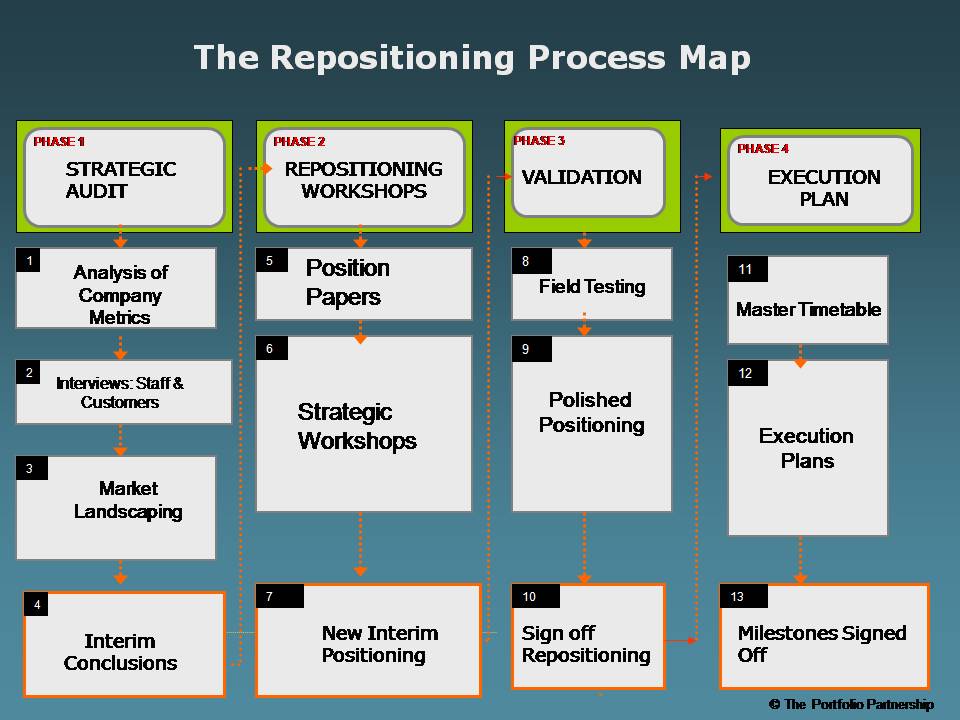Last week I published The Saleability Test describing the 15 key drivers that drives a buyer’s thinking. The key issues that determine just how saleable your business might be. Well assuming you want to improve your score I’ve reconciled those 15 key drivers to my 9 Playbooks, to help you drive your business forward. See here.
I’ve devoted this weeks blog post to the first and arguably the most important Playbook, Positioning. Who do you want to be? Do you want to be remarkable or invisible? (Seth Godin) This Playbook will ensure your story is compelling and that the results you achieve for customers are compelling.
Today’s environment is a great opportunity to reposition your business….To ask yourself – what business am I in? When trading is racing along, do we really analyze our successes? Malcolm Gladwell’s book, Outliers, highlights the need to understand why we are successful and why we fail. CEOs are trying to internalize the data coming into them and it’s not pretty. I like to call it the “audit of signals”. A sign of great leadership is a relentless curious mind, continually questioning why the business is performing well or not. It is this constant measuring of the signals, the macro trends, the micro trends, seeking patterns for relevance that is key.
When you are working feverishly inside your bottle it is difficult to read the label on the outside! Are you really servicing the current needs of the market? This simple process map below may help you. If executed well it should allow the management team to rebuild a vision for their company that meets the current needs of a unique market and inspires every member of staff to make a difference. Build a remarkable business that defines your unique market. Be clear on the business result you can achieve for your customer. Use this Process Map to guide your thinking.
Let’s review the stages in a little more detail.
Phase 1 – Strategic Audit
Repositioning a company starts with a discovery process. It starts with great questions. Are consumption patterns changing, are business models emerging, why are margins dropping, is new legislation coming at me, is market share dropping off? There are literally hundreds of important questions that need answers, and these answers need insightful interpretation.
Box 1: Look for signals that determine what is working and why, identify lack of focus, inconsistencies
Box 2: Use diagnostic questions to understand what the market needs and what you are good at
Box 3: Understand your competitors offerings and their success rate, understand macro trends and market needs
Box 4: Draw together insightful conclusions into your current performance, articulating your current positioning
Phase 2 – Repositioning Workshops
This is a great technique for reviewing the best way forward. To really rehearse potential market segments that you could dominate based on your unique skills. This is no easy task. There is still too much mystery interpreting the significance of market events eg banking, newspapers, music, software, automotive sectors have all been generating a plethora of signals to their respective players that repositioning is essential! The result of this disconnection between the external data and execution of a new strategy is a collection of businesses who have lost their way, Borders, Motorola, Nokia, RIM, and a 1000 private companies that also missed the bend in the road.
Box 5: Each participant to a workshop is allocated a key position paper to prepare, distributing it in advance of the workshop. This builds great engagement to the debate and ensures issues are thoroughly researched to allow thoughts in workshop to flow smoothly.
Box 6: Focus on defining:
- Your unique market you will dominate and the secret sauce ingredients that make you sound authentic.
- New messaging needs to be created articulating the business results you will achieve for your customers. You are in the business of improving your client’s business. How does your product or service improve the performance of your client. You need to understand the client’s client.
Box 7: Define your new positioning, feel some passion for this vision, you need to believe it will transform your company’s future
Phase 3 – Validation
It is so easy to believe your own hype. You need to stress test your positioning and sales scripts with real people – your customers. Engage in deep conversations with your prospects and customers to understand what is resonating. Are you really scratching a big itch in the market? Even if it exists does it appear on your customer’s priority list? Test drive the scripts and listen carefully using diagnostic questions to understand what really keeps them up at night.
Box 8: Engage in deep conversations with special customers, testing your new words, your value propositions
Box 9: Gather your feedback and fine tune your Positioning, messaging, words that will compel your customers to act
Box 10: Spend time articulating your new new strategy at the macro level and at the micro product level
Phase 4 – Execution Plan
The execution of a compelling story, a great positioning, requires management to recognize that all moving parts of the business need to embrace this execution. Operations, sales, marketing, product road maps, everything needs to recalibrate around your defined identity.
Box 11: Draw up your master implementation plan, allocating one senior manager to be accountable for each piece
Box 12: Build detailed roll-out plans for each key circle of influence (each functional area) in your company & don’t forget to educate your own staff
Box 13: Build accountability into your Complete Positioning Project & set milestones to measure success
Call to action
I really hope that adds value to your thinking wherever you are on the lifecycle of your business.
Is your positioning up to scratch? Are you working on the right stuff? – Want a health check? – give us a call to start the conversation.









